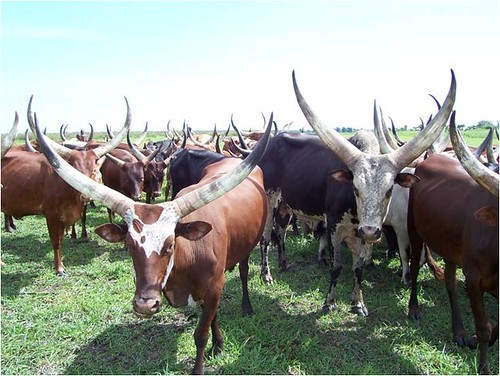By Danielle Nierenberg & Amanda Stone
 The year 2010 was declared the International Year of Biodiversity by the United Nations and not surprisingly, the focus lay mainly on the usual species the public recognizes and adores, without addressing the bigger issues.
The year 2010 was declared the International Year of Biodiversity by the United Nations and not surprisingly, the focus lay mainly on the usual species the public recognizes and adores, without addressing the bigger issues.
It isn’t only pandas and rainforests that need protecting. There are also thousands of varieties of grains, vegetables, fruits, and livestock breeds found in fields, forests, corrals and pastures all over the world that need to be conserved, protected and valued.
Over the last century, the human appetite for meat, milk, and eggs has soared in both industrial countries and the developing world. Meat production has been consolidated and industrialized, threatening many of the indigenous species and decreasing both farmer and consumer connection to animals.
Fortunately, there are ways to both raise livestock and protect biodiversity.
A variety of methods of producing more environmentally sustainable meat, including grassfed meat production, rotational grazing and zero grazing, are already being practiced in the US and Africa.
In Zimbabwe, Osmond Mugweni, director of the Njeremoto Biodiversity Institute, developed a rotational grazing technique that avoids overgrazing by regulating where the livestock go according to a grid system, allowing enough time for the grass to recover. To share his ideas Osmond reaches out to farmers using radio programs and newsletters and trains small-scale and commercial farmers at his centre.
Several United States Department of Agriculture studies have shown that rotational grazing not only preserves biodiversity, but that unfertilized, natural grasslands and prairies act as carbon sinks, sequestering carbon dioxide in soils and preventing it from contributing to global warming.
In both Ghana and Rwanda Heifer International is working with farmers to learn about zero grazing practices and growing traditional fodders. The farmers build stalls for their cows instead of letting them graze freely and potentially polluting waterways or overgrazing pastures.
Unlike the animals raised in factory farms, livestock raised on grass or on a small-scale where they’re not crowded together, tend to be better adapted to harsh climatic conditions and more resistant to disease.
Another important way of preserving and maintaining biological, agricultural, and cultural biodiversity is through protecting livestock keepers’ rights.
Pastoralists in Africa have bred indigenous species for generations that are often better able to resist disease, survive in hot climates, or travel long distances in search of water. Unfortunately, the introduction of foreign breeds of cattle for increased meat and milk production has diminished genetic diversity and often pushed pastoralists out of their traditional grazing land.
NGOs such as the African LIFE Network are working to increase rights for livestock keepers. Jacob Wanyama, a coordinator of the Network, said: “Governments need to recognize that pastoralists are the best keepers of genetic diversity….Ankole cattle are one of the ‘highest quality’ breeds because they can survive in extremely harsh, dry conditions,” — something that’s more important than ever as the impacts of climate change become evident in Africa.
As consumers of meat, we can also help prevent the loss of biodiversity. Many international studies, doctors and dieticians have recommended that consumers reduce their meat consumption by about 10%. More plant-based diets could play an important role in preserving environmental resources and in reducing hunger and malnutrition in poorer nations.
Despite these recommendations, meat consumption in wealthy countries is still high. The US eats a shocking 127kg of meat per year, almost twice as much as even the most carnivorous countries in Europe and Latin America.
Fortunately, some farms and businesses, including Heritage Foods USA, are committed to humanely raising and selling heritage and endangered breeds of vegetables, grains, cows, pigs, goats, chickens, and other livestock.
According to Patrick Martins, founder of Slow Food USA and co-founder of Heritage Foods USA: “While pandas and spotted owls will be saved in zoos and wildlife preserves, breeds like the Red Wattle and the Tunis lamb, whose job in life is to be food, will only be saved by being reintroduced onto American dinner tables.”
Policy-makers and governments are also taking the initiative to reduce consumption in their own countries. Germany revised their food pyramid in 2004 to emphasize reduced consumption of animal products. In 2003 the John Hopkins School of Public Health started the successful Meatless Mondays campaign. It sparked interest among school systems, consumers, and even celebrity chefs, like Mario Batalli, globally.
These are just a few of the ways that farmers, policymakers, and consumers can help ensure more environmentally sustainable meat production. Livestock keepers and ranchers need more education and training and more financial support to become better stewards of biodiversity. We, as consumers, can also be more conscious about where our food is coming from. We can all eat a little less meat and little more locally in celebration of our planet’s biodiversity.


